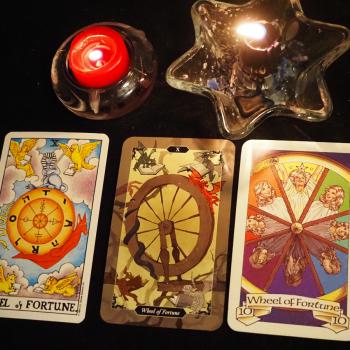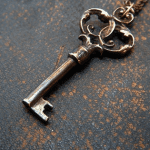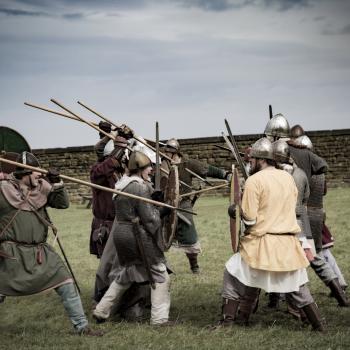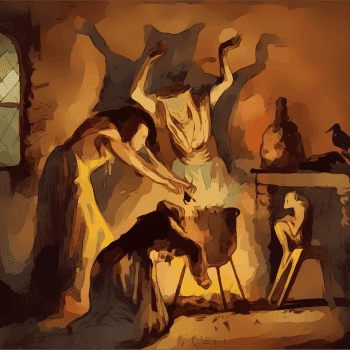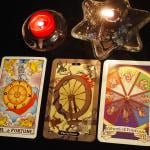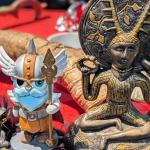The practice of head covering can be a pretty heated topic, rife with histories of racism and oppression. For some reason, people tend to lose their minds when they see a woman wearing a veil or head scarf; friends of mine have had people yank their head coverings off their heads. I guess once they graduated kindergarten they forgot about the “keep your hands to yourself” rule. But I can only handle so much controversy at once, so for now, let’s focus on the concept of veiling and head coverings in religious practice, heathen-style. Specifically, why I, a rag-tag Lokean who doesn’t give a whit about modesty or submission to higher powers, choose to veil whenever I leave my house.
Anyone who’s ever had an interest in veiling/covering one’s hair knows at least some of the history. Covering one’s head/hair was often more a matter of practicality than fashion or spirituality: washing long hair is a chore, especially when you don’t have indoor plumbing, water heaters, and hair dryers. It signified a woman’s marital status in some cultures and class status in others. And sometimes, a scarf or veil was just a pretty accessory with no deeper significance at all.
In modern culture, religious covering evokes images of Catholic nuns and Jewish women with their array of beautiful tichels, and of course, Islam. Some might even associate it with a few branches of Christianity, particularly those leaning towards fundamentalism (ironically, I order all of my “Lokean nun” veils from a Christian veil shop!). In the pagan and polytheistic world, Hellenes are the first to spring to mind with veiling, particularly devotees of Hestia. Heathens of the Norse and Germanic variety aren’t particularly known for veiling, but we’re out there (in more ways than one, I suppose).
As one bound to Loki, my preference for veiling is especially unexpected. The Trickster is an archetype across many cultures beloved (and bemoaned) for turning social order and expectations on their head. Devotees of such figures tend to be fairly transgressive themselves, poking holes in accepted narratives and mucking about with exposing what’s hidden behind ego and hubris. Modesty and submission aren’t something deities like Loki concern themselves with, and falling into line with tradition depends on the benefits offered. But then again, maybe it isn’t such a shock for a Lokean to cover their heads. Y’all expect us to be as outrageous and out of control as possible, so I’ll subvert that by being all cute in my veils and Dublin caps.
Sigyn’s wisdom nudged me into the practice
That said, my veiling has less to do with Loki and more to do with his wife. As frustrating and maddening as Loki can be, Sigyn balances him out nicely and makes it all worthwhile (I say as though I don’t adore Loki’s twerpiness). For those not familiar with her, the only context in Norse mythology in which she’s presented is during Loki’s punishment. When he’s bound to the rock beneath the earth, the giantess Skadhi hangs a venomous snake above Loki’s face. Sigyn, his wife, stays with him in the cavern, holding a bowl to catch the venom. It’s a quiet act of love and compassion, staying by his side to keep him company, shielding his eyes from the searing burn of the toxin.
Sigyn has been almost as active and present in my life as Loki these last few years, and I cover my head in honor of her. A few years ago, I started feeling the compulsion to veil. As I tend to do with any kind of New Spiritual Thing being brought to my attention, I dragged my feet and ignored it. Read up on it a bit, talked with a Very Good Friend who wears tichels, but declined to adopt it into my own practice. I’m supremely irritating in that way (among many other ways); I’m hyper-religious, but I’m also skeptical about spiritual pings and twinges and tend to ignore them for as long as I can until the universe really gets in my face about it.
The Universe is becoming tech-savvy. The tug towards veiling intensified in February of 2019, but I didn’t start the practice until November of that year because of a curious glitch in a messaging app that I don’t use. In the months between, Loki teased me for wanting to cover so that I wouldn’t have to wash my hair quite as often/didn’t have to fight with the absurdly thick and wild mane of mine to look vaguely presentable in polite society. Sigyn was a bit more thoughtful and sincere, and ultimately it was her input that pushed me into donning the veil. She told me in meditation, normal “chatter,” and possibly via the mystery text that appeared on my phone and not my friend’s, that veiling can be an act of protection, a symbolic shield to keep your head from being burned by the serpent’s venom.

Veiling is surprisingly freeing on a personal and spiritual level
I started veiling in November of 2019. It’s been one year of covering my hair every time I leave the house, and I’ve no plans of curbing this habit (heh). I’ve found that it frees up quite a lot of mental energy from worrying about how I look and what my ridiculous mane is doing (I admit I’ve been visibly startled in public more than once by my hair popping into my peripheral vision like someone rushing at me). I don my veil and a sense of calm and peace envelops me, not unlike the sensation of snuggling in under a weighted blanket. Friends and colleagues remark that my energy has changed since I started covering, that I seem more serene and comfortable (see above: scared of my own hair attacking me). My confidence has soared in a strange way: it feels as though I’m finally embracing the long-held draw to monastic life that appealed to me when I dabbled in Christianity as a young teen. Besides, I think I look much cuter than I have any right to in my veils.
As someone who’s fairly empathic, it absolutely fulfils Sigyn’s promise of serving as protection from venom. It’s like a metaphorical shield, a physical representation of my own spiritual and emotional defenses. Because it’s a visible sign of faith that draws curiosity, it’s a great way to start conversations as well. Not that I’m trying to proselytize, it just helps me to be more visible in my local community to represent inclusive heathenry. Norse heathenry has a stigma in mainstream media about it’s appeal to racists and bigots. I’ve always let my own actions and community work speak to the general public about what heathenry really is to those who practice it. People see the veil and my prominent Mjolnir pendant and runic pendants, and they naturally have questions which I cheerfully answer. Some heathens are afraid to wear visible religious jewelry because they don’t want to be confused for neo-Nazis, but in my experience, the veil helps offset the fear and makes people feel comfortable and safe, so they’re not afraid to ask questions. It’s an easy way to start a dialogue, and people in my city have responded really well to the weird little Lokean nun buying cigarettes at the corner store.
Besides, I have saved so much money on hair product. I’m no longer drowning in a bathroom full of creams, serums, sprays, gels, and oils that fail to deliver on their promises of controllable, frizz-free locks.
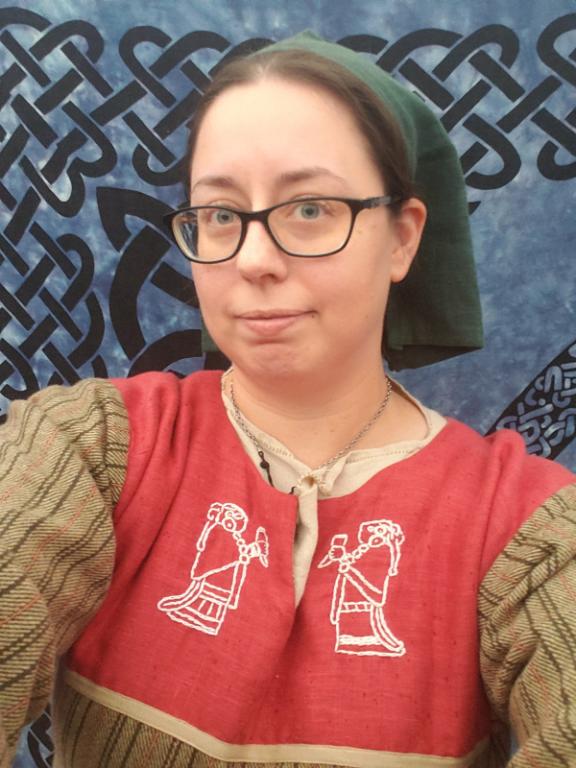
There’s value in veiling
It’s definitely not a practice for everyone, but there’s something pretty damn fun about identifying as a heathen nun with a veil while my heavily-tattooed self is chain-smoking and cursing up a blue streak and whipping around in my GTI with Black Sabbath on blast. It’s just so damn satisfying. I really wasn’t anticipating just how much it would free up my mind and attention away from the mundane to better help me focus on the spiritual in my daily life and routine.
My pull towards veiling isn’t something that’s been asked of me; neither my gods nor my community suggested it, just responded to. It’s something I’ve been curious about, a personal interest that stems from my long time obsession with nuns and monastic life. I’m neither modest nor conservative (as a Lokean, how could I possibly be either?!), but there’s a distinct comfort and freedom in wearing the veil. It’s a social signal about how I’ve decided to devote myself fully to my spiritual practice, it reminds me to be ever mindful of my gods (not that I need help with that) and how I represent them, it comforts my anxious mind, and I look ridiculously cute and don’t have to wonder what the hell my hair is up to. I just feel better overall when I pin my veil in place and get my nun on.
If nothing else, it’s just an incredible feeling to walk down the street without jumping sideways and yelping every time a wayward curl of hair pops free and into my peripheral view. I do so enjoy the mundane benefits of my spiritual habits!




